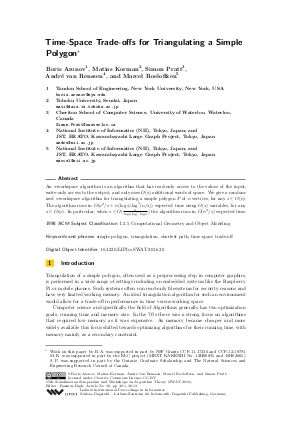Time-Space Trade-offs for Triangulating a Simple Polygon
Authors Boris Aronov, Matias Korman, Simon Pratt, André van Renssen, Marcel Roeloffzen
-
Part of:
Volume:
15th Scandinavian Symposium and Workshops on Algorithm Theory (SWAT 2016)
Part of: Series: Leibniz International Proceedings in Informatics (LIPIcs)
Part of: Conference: Scandinavian Symposium and Workshops on Algorithm Theory (SWAT) - License:
 Creative Commons Attribution 3.0 Unported license
Creative Commons Attribution 3.0 Unported license
- Publication Date: 2016-06-22
File

PDF
LIPIcs.SWAT.2016.30.pdf
- Filesize: 0.54 MB
- 12 pages
Document Identifiers
Subject Classification
Keywords
- simple polygon
- triangulation
- shortest path
- time-space trade-off
Metrics
- Access Statistics
-
Total Accesses (updated on a weekly basis)
0PDF Downloads0Metadata Views
Abstract
An s-workspace algorithm is an algorithm that has read-only access to the values of the input, write-only access to the output, and only uses O(s) additional words of space. We give a randomized s-workspace algorithm for triangulating a simple polygon P of n vertices, for any s up to n. The algorithm runs in O(n^2/s+n(log s)log^5(n/s)) expected time using O(s) variables, for any s up to n. In particular, the algorithm runs in O(n^2/s) expected time for most values of s.
Cite As Get BibTex
Boris Aronov, Matias Korman, Simon Pratt, André van Renssen, and Marcel Roeloffzen. Time-Space Trade-offs for Triangulating a Simple Polygon. In 15th Scandinavian Symposium and Workshops on Algorithm Theory (SWAT 2016). Leibniz International Proceedings in Informatics (LIPIcs), Volume 53, pp. 30:1-30:12, Schloss Dagstuhl – Leibniz-Zentrum für Informatik (2016)
https://doi.org/10.4230/LIPIcs.SWAT.2016.30
BibTex
@InProceedings{aronov_et_al:LIPIcs.SWAT.2016.30,
author = {Aronov, Boris and Korman, Matias and Pratt, Simon and van Renssen, André and Roeloffzen, Marcel},
title = {{Time-Space Trade-offs for Triangulating a Simple Polygon}},
booktitle = {15th Scandinavian Symposium and Workshops on Algorithm Theory (SWAT 2016)},
pages = {30:1--30:12},
series = {Leibniz International Proceedings in Informatics (LIPIcs)},
ISBN = {978-3-95977-011-8},
ISSN = {1868-8969},
year = {2016},
volume = {53},
editor = {Pagh, Rasmus},
publisher = {Schloss Dagstuhl -- Leibniz-Zentrum f{\"u}r Informatik},
address = {Dagstuhl, Germany},
URL = {https://drops.dagstuhl.de/entities/document/10.4230/LIPIcs.SWAT.2016.30},
URN = {urn:nbn:de:0030-drops-60522},
doi = {10.4230/LIPIcs.SWAT.2016.30},
annote = {Keywords: simple polygon, triangulation, shortest path, time-space trade-off}
}
Author Details
References
- B. Aronov, M. Korman, S. Pratt, A. van Renssen, and M. Roeloffzen. Time-space trade-offs for triangulating a simple polygon. CoRR, abs/1509.07669, 2015. URL: http://arxiv.org/abs/1509.07669.
-
T. Asano, K. Buchin, M. Buchin, M. Korman, W. Mulzer, G. Rote, and A. Schulz. Memory-constrained algorithms for simple polygons. Computational Geometry: Theory and Applications, 46(8):959-969, 2013.

-
T. Asano and D. Kirkpatrick. Time-space tradeoffs for all-nearest-larger-neighbors problems. In Proc. 13th Int. Conf. Algorithms and Data Structures (WADS), pages 61-72, 2013.

-
T. Asano, W. Mulzer, G. Rote, and Y. Wang. Constant-work-space algorithms for geometric problems. Journal of Computational Geometry, 2(1):46-68, 2011.

- L. Barba, M. Korman, S. Langerman, K. Sadakane, and R. I. Silveira. Space-time trade-offs for stack-based algorithms. Algorithmica, 72(4):1097-1129, 2015. URL: http://dx.doi.org/10.1007/s00453-014-9893-5.
-
L. Barba, M. Korman, S. Langerman, and R. I. Silveira. Computing the visibility polygon using few variables. Computational Geometry: Theory and Applications, 47(9):918-926, 2013.

- B. Chazelle. Triangulating a simple polygon in linear time. Discrete & Computational Geometry, 6:485-524, 1991. URL: http://dx.doi.org/10.1007/BF02574703.
- S. Har-Peled. Shortest path in a polygon using sublinear space. In Proceedings of the 31st International Symposium on Compututational Geometry (SoCG), pages 111-125, 2015. URL: http://dx.doi.org/10.4230/LIPIcs.SOCG.2015.111.
- M. Korman. Memory-constrained algorithms. In Ming-Yang Kao, editor, Encyclopedia of Algorithms, pages 1-7. Springer Berlin Heidelberg, 2015. URL: http://dx.doi.org/10.1007/978-3-642-27848-8_586-1.
-
M. Korman, W. Mulzer, M. Roeloffzen, A. v. Renssen, P. Seiferth, and Y. Stein. Time-space trade-offs for triangulations and voronoi diagrams. In Proc. 14th Int. Conf. Algorithms and Data Structures (WADS), pages 482-494, 2015.

-
J. E. Savage. Models of Computation: Exploring the Power of Computing. Addison-Wesley, 1998.

